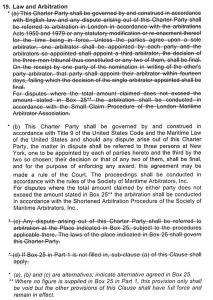Internaves de Mexico s.a. de C.V. v. Andromeda Steamship Corp., 2018 WL 3636427 (11th Cir. Aug. 1, 2018), demonstrates the perils (and costs) of inconsistency in an agreement’s dispute resolution provisions. Internaves and Andromeda were parties to a “charter party” agreement for the transportation of an electric transformer from Brazil to Mexico. The agreement, completed using a form with fillable blanks in Part I and pre-printed language (some struck through) in Part II, included the following text at Box 25 in Part I:
 . Thus Box 25 specified “London arbitration, English Law.” But in Clause 19 in Part II of the agreement, also titled “Law and Arbitration,” all but one of the alternative subparagraphs had been struck through. The remaining provision called for arbitration “at New York”:
. Thus Box 25 specified “London arbitration, English Law.” But in Clause 19 in Part II of the agreement, also titled “Law and Arbitration,” all but one of the alternative subparagraphs had been struck through. The remaining provision called for arbitration “at New York”:
The contract also included a provision that “[i]n the event of a conflict of conditions, the provisions of Part I shall prevail over those of Part II to the extent of such conflict.”
A dispute arose between the parties about whether the vessel and/or the freight had been delivered as required, and in 2016, Internaves sued Andromeda in the Southern District of Florida. Andromeda moved to compel arbitration in London. The district court determined that Box 25 and Clause 19 were hopelessly in conflict, acknowledging that the agreement called for Part I to govern in case of inconsistency but finding that subparagraph 19(c) “also provided for the supremacy of Part I”—and had been struck through. The district court thus compelled arbitration in its own district, the only option available to it in the absence of an agreement between the parties as to location. Andromeda appealed.
The Eleventh Circuit, in an opinion written by Judge Marcus and joined by Judges Fay and Hull, reversed. Reviewing the issue de novo, the court held that the agreement’s conflict clause governed, resolving the inconsistency, and that the agreement required arbitration in London under English law.
The court began by noting that “[i]ssues arising out of arbitration agreements are generally resolved by contract-law principles, pursuant to which we attempt to ascertain the parties’ intent through the words they use,” and that international arbitration agreements are governed by the Convention on the Recognition and Enforcement of Foreign Arbitral Awards (the “New York Convention”), codified at Chapter 2 of the Federal Arbitration Act. That chapter provides that a district court “may direct that arbitration be held in accordance with the [arbitration] agreement at any place therein provided for, whether that place is within or without the United States.” 9 U.S.C. § 206. (Chapter 1 of the FAA, on the other hand, authorizes courts only to compel arbitration in their own districts. 9 U.S.C. § 4.)
Turning to whether the parties had in fact provided for a specific forum, the court employed federal common-law principles of contract interpretation to determine that Box 25 in Part I of the parties’ agreement—which provided for arbitration in London—controlled. Most importantly, the agreement’s conflict clause provided for the superiority of Part I over Part II. Further, “London arbitration, English Law” had been inserted as additional text in Box 25, in contrast to the strikethroughs (or absence thereof) in Clause 19. And Clause 19 itself indicated that Box 25 was authoritative, directing the parties to indicate the Clause 19 alternative to which they had agreed “in Box 25.”
The Eleventh Circuit was unpersuaded by the argument, successful in the district court, that the parties’ having struck through subparagraph 19(c), which referred to Box 25, undercut the agreement’s general provision that Part I controls over Part II in case of a conflict. The struck-through 19(c), the court said, “does not ‘provide for the supremacy of Part I,’” but rather provides that if the parties choose a seat other than New York or London—the two most common choices in maritime agreements—they may “write in” that jurisdiction in Box 25. Crossing out that provision did not negate the otherwise applicable conflict clause, and so the place chosen in Part I of the agreement controlled.
Posted by Valerie Sanders.

